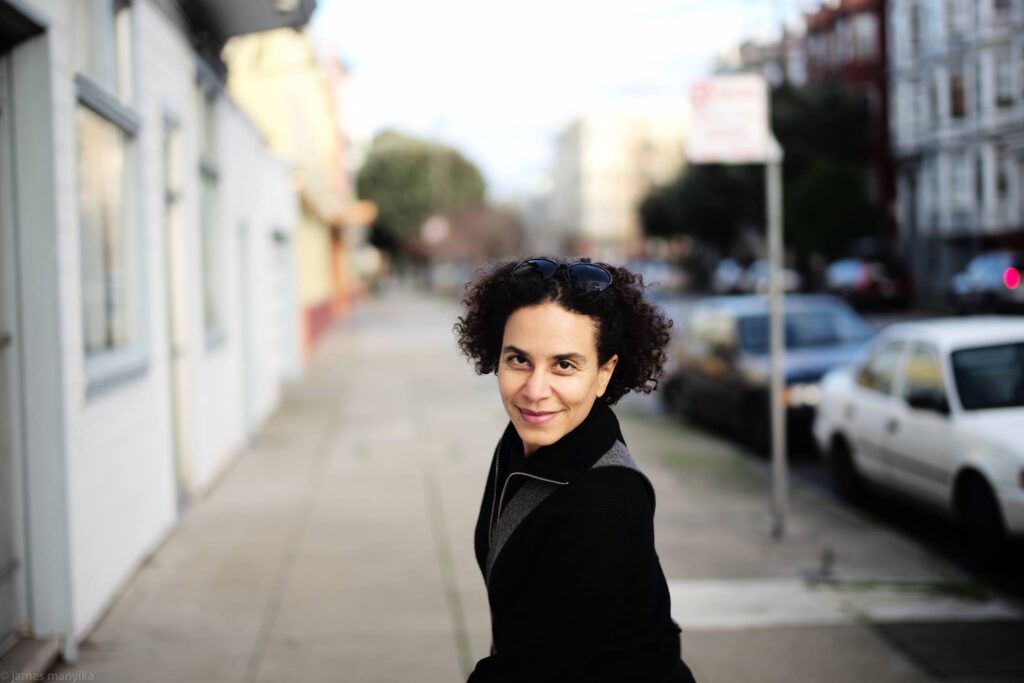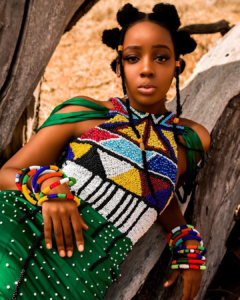


You’ve shared with me, via the unpublished essay, how you got your instinct for other people’s stories. You term yourself “a compulsive eavesdropper, regularly, unabashedly tuning out of one conversation for another if a riff catches my ear — a tone, rhythm, accent or dialect. And when I sense a good story, especially one untold or little known, then my curiosity becomes insatiable.” You know everyone in this book. Some of the subjects were guests from Conversations Across the Diaspora, your series for the Museum of the African Diaspora (MoAD) in San Francisco. How did the idea to make these encounters into a book come to you?
For as long as I can remember, I’ve been curious about other people’s lives and have enjoyed discovering and sharing the more unusual or lesser-told stories. And because I have a store of such stories, collected over the years, many of which seemed to speak with particular pertinence and urgency to our times, I was delighted when the editor Candida Lacey approached me to put together this book. I’m fortunate to have had opportunities to meet and get to know such an impressive group of people — some famous, others not. To be able to now share the insights and wisdom that I’ve gleaned from these encounters gives me great joy.
Your profile of Toni Morrison first came out in 2017. It conveys that sense of the magical in how you are sitting with this widely revered figure, in privacy. It’s different with Michelle Obama, not just because yours were public meetings but because she has always had a powerful public charisma that people connected to in a personal way — which is interesting in that she is the one that left you, someone unfazed by celebrity, starstruck. These are all people who are known by and have influenced millions. How, like in the case of Ms. Morrison, are you able to find a strong sense of private connection to public figures — enough to enable them open up to you?
For me, establishing a strong sense of personal connection with anyone whose story fascinates me stems from having a genuine interest in the person. The connections are never contrived and that’s what I think makes people, especially public figures, feel comfortable and also creates trust in our interactions. This, in turn, allows for depth and intimacy in the conversations.
With the writers Wole Soyinka and Toni Morrison, my connection comes through a shared vocation and a common commitment to how and what they write — stories I want told and retold without compromise. In the case of Michelle Obama, we connected initially through mutual friends and then around our writing and also as mothers raising children of similar age in America.
But I think it’s also important to add that when I decide to write about someone, or publicly record a conversation, it’s never the first of my encounters with that person. Rather, it’s a snapshot from a larger canvas of encounters over time and in various contexts. With Michelle Obama, I had interacted with her in a variety of contexts, from the White House to intimate settings with our families and friends, to a mega stadium during her book tour, to my own quiet time alone with her book. In contrast, with Toni Morrison I only had one magical afternoon in her home out of many encounters with her work over the years. I’d read and taught her novels and essays and listened to her interviews. And when I first read Morrison’s work it wasn’t with a view to write about her years later. I was simply curious about her and her stories but then, of course, became hooked!
No matter how well I know a person, before doing what may become a public conversation, I prepare and research. This gives me the nimbleness to pursue wherever my curiosity and our conversation might lead and to listen as closely as possible to words, silences, and body language. And because it’s a conversation, it’s a give and take. We share views and experiences and sometimes we disagree but mainly we find joy and generate new ideas and stories.
In her Introduction, Bernardine Evaristo writes that “this book reveals, through various life stories, what it has taken for these people to succeed. . . what it takes to be an original thinker who forges your own path, and what it takes to become a leader.” What was most surprising to you about their individual stories?
One of the things that was the most surprising was the actual extent to which each of those featured forged their own path. Take Henry Louis Gates, Jr., for example, who thought he was destined for medical studies but instead changed course to be a student of literature and history and ultimately ended up building a whole new discipline in African and African American Studies.
Margaret Busby was barely in her twenties when she set out to found her own publishing company, becoming the youngest and first ever Black British woman publisher. All her life she has faced the twin challenges of sexism and racism and all the other ways that society “others” us, and yet she persevered. Or take Evan Mawarire, an ordinary citizen and pastor turned civil rights activist, who brought a nation to a standstill when he dared to take on Robert Mugabe, a president who ruled for 37 years with an iron fist.
In many ways those in this book are sui generis. Each have singular stories forged in different parts of the world, different backgrounds and personal experiences, and yet there are surprising similarities in the difficulties they’ve each encountered along the way. Irrespective of whether we are talking about America, Nigeria, England, or Zimbabwe, there are shared experiences of fragile democracies, police brutality, and racial discrimination—barriers upon barriers people have had to push against and push through.
This is why the book title Between Starshine and Clay, borrowed from Lucille Clifton’s poem “won’t you celebrate with me,” is so important. Her poem speaks of survival through adversity and combines a blunt acknowledgement of how hard it is to survive, to forge one’s own path, and yet to pull through and have something to celebrate.
Wole Soyinka speaking about his friendship with Toni Morrison and the chat being crashed by his friend Henry Louis Gates, Jr., was striking, because it revels in the joy of companionship, the sacredness of friendship. What has been your own experience with literary friendships?
When I think of literary friendships, I think of both intimate and contemporaneous friendships across literature and time. I was particularly struck by how James Baldwin had been a friend to almost all in this collection. Some, like Tony Morrison, Margaret Busby, and Henry Louis Gates, Jr., knew him in real life whereas others such as Claudia Rankine, Cory Booker, and myself had a literary friendship with him primarily through his work.
There are also friendships across different kinds of storytelling; for example, the friendship that I have with Anna Deavere Smith is one where my own writing has been enriched and inspired by her theatre. Similarly, with Xoliswa Sithole, I’ve been inspired by knowing her and her powerful storytelling through film.
With Willard, many of our weekly walks have included conversations about literature. Sometimes we’re both reading the same book — Isabel Wilkerson’s Caste: The Origins of our Discontents or Michelle Obama’s Becoming — but other times Willard tells me about books I haven’t read. One such book was Sanjay Gupta’s Keep Sharp: Build a Better Brain at any Age. This didn’t seem to me to be a book she needed to read — if anything, as I told her, it was a book she was uniquely qualified to write.
Outside of those in Between Starshine and Clay, I’m grateful for all sorts of literary friendships with people who’ve inspired, nurtured, and encouraged me over the years. I mention some by name in my acknowledgements.
Mrs. Willard Harris was 102 years old when you spoke to her for the book. She was born in 1919, the year white American women won the right to vote, and grew up picking cotton, then became the first Black head of nurses at a major Californian hospital, and was, at age 100, running your local polling station. As you put it, “she has lived through an extraordinary century” and is “a living archive of us.” You also compare her to Dr. Morayo Da Silva, the character in your second novel Like a Mule Bringing Ice Cream to the Sun. And yet, next to the cultural icons in this book, she is a regular person, even with her rich life, which she wouldn’t quite accept as “exceptional.” First, how long did it take you to decide that someone who isn’t famous deserves a seat at the table with these icons? And second: When she asks you, “Don’t you think we’ve come a long ways?” I sense a withdrawn intergenerational tension about racial progress — it is not explicitly stated in the book but I sense it between you and her. Was it there? And did you, in this time when black people know not to accept less, think of that interaction as perspective gained?
Intergenerational tension. That’s an interesting question for me when it comes to someone like Willard because one of the most remarkable things about her, now at age 103, is how young in spirit she is. She’s always wanting to learn and frequently questioning her assumptions and mulling over what she could have done better. She’s an extremely attentive listener, so honestly the intergenerational tension is really not there. The perspective that I have gained from Willard comes from the way she embodies what Baldwin describes as the necessity of sometimes having to hold onto two seemingly contradictory things: remaining committed to the struggle against injustices while keeping one’s heart free of hatred and despair.
Willard doesn’t carry rancor but rather always seems to look forward, and from this I draw wisdom and perspective. She’s seen everything from World Wars to Jim Crow, the Civil Rights and the Black Lives Matter movements, Roe v. Wade and its repeal, to say a few. And yet, when you sit with her, she’s like a young person. She’s looking ahead and wants to understand.
Literally, while I was typing this, she just happened to phone me to talk about AI. Yes, Artificial Intelligence. With laughter in her voice and with a child’s excitement, she told me of her first ride in a driverless car. Had I done that yet? No, I hadn’t. So, if it’s not already obvious, Willard Harris is actually the biggest superstar of the book. The question is not why I would decide to include her, but how to decide who was good enough to include alongside her.
Over the years, notably during your time as Books Editor at OZY, you interviewed and profiled a host of creatives and thinkers, but, in Between Starshine and Clay, only the most culturally significant personalities appear. How did you decide who to include in the book?
As I say in my introductory chapter there are many inspiring voices that could have been included in a book like this, but the twelve chosen are amongst those whose work I’ve engaged with deeply and whose stories I find particularly resonant in these times. They are also people I’ve spent time with over the past few years. The span of interactions with each person is different and what I learn varies from person to person. But what they all have in common is a deep appreciation of generative and necessary conversation, of its healing power, of its potential to widen our horizons, and spark our imaginations.
Many have given speeches, written articles and books that speak to the promise and the limits of conversation — from Toni Morrison’s magisterial Nobel Prize lecture on the complex truths of language to Cory Booker’s heart-warming memoir United: Thoughts on Finding Common Ground and Advancing the Common Good, to Anna Deavere Smith’s ode to deep listening in Talk to Me: Listening between the Lines. Likewise, Claudia Rankine’s book-length poem, Just Us: An American Conversation,shows us how difficult these dialogues can be.
Yet sometimes, as Rankine notes, a conversation that is “random, ordinary, exhausting, and full of longing to exist in some image of less segregated spaces” may surprise us and break open. And again, in addition to the twelve I feature, there are so many more — yourself included — whose stories we must hear.
You named Ngũgĩ wa Thiong’o as someone “who would have been in this collection had time and schedules permitted.” And while I appreciate Bernardine Evaristo’s Introduction, I would have liked to see her as a subject. Who else, aside Ngugi, would you have liked to feature but could not?
Ngũgĩ wa Thiong’o is someone whose work I’ve engaged with deeply over the years, whose stories I find resonant in these times, and with whom I’ve also spent time. Some of my most memorable encounters with him have been over long evening meals with friends and family in our home in San Francisco. I’ve particularly enjoyed observing his interaction with other writers in his family, his sense of humor, and his skills as an oral storyteller. He also has such a generosity of spirit. I remember, in 2019, sitting next to the writer Namwali Serpell at a talk he gave in San Francisco, and being surprised that he started his remarks by recognizing both of us and highlighting our work.
Bernardine, as you note, is wonderfully present through the book’s Foreword, which she kindly wrote, but she could easily have been the subject of a chapter. Were I to write a longer piece on Bernie, I would highlight the impact and importance of her literary works as well as her curatorial powers and the many ways she’s encouraged other writers. We’ve met in many parts of the world, most recently in Amsterdam, where, after her Booker Prize, it was fun to see complete strangers now recognizing her and stopping to say hello and express their enthusiasm for her work.
In addition to Ngũgĩ and Bernie, there are so many more artists, creators, and changemakers I could have included, many of whom I highlight in my introductory chapter. Sticking to those that I’ve been lucky enough to meet several times, the musician Jon Batiste, with his African Diasporic interests, is someone I’d like to write about one day. I’d also like to include others outside the humanities and politics — people like the NBA star Giannis Atentekampo, or the philanthropists Strive Masiyiwa (who is included in my series for MoAD) and Tsitsi Masiyiwa, or the fashion designer Duro Olowu. I’d also love to write about people like Mukoma Sam, a wise, older gardener in Harare, or young Simbi in London, a Mandarin-speaking, designer-writer-technologist.
The art of the conversation is a dig into memory and context, and with the global histories of blackness, it becomes charged with as much pain as joy. What makes a conversation transcend its moment and speak to the wider culture?
I suspect that those are the conversations that don’t consciously set out to “transcend.” They are conversations that speak to what we endlessly aspire or strive towards — the idea of progress, of a fairer more equitable society, of a better world for future generations. They are conversations that touch on stories that are a reflection of all of us (any of us) and speak to certain truths and universal human experiences.
I’m reminded now of the allegory at the center of Toni Morrison’s Nobel lecture, and the ultimately transcendent conversation between the old woman and her young audience, which ends with the line: Look. How lovely it is, this thing we have done – together. Perhaps the most transcendent of conversations are those built together, those that get us to the jazz, afrobeat, and jollof of life. ♦
Correction (July 20, 2023): A previous version of this interview wrongly stated that Manyika’s Profile of Toni Morrison was first published in 2019, and not the correct year, 2017.
by Otosirieze






